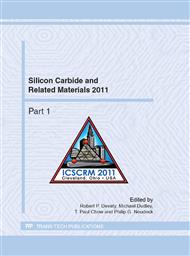p.113
p.117
p.121
p.125
p.129
p.133
p.137
p.141
p.145
Electrical and Optical Properties of High-Purity Epilayers Grown by the Low-Temperature Chloro-Carbon Growth Method
Abstract:
A reduced growth pressure (down to 10 Torr) was employed for the low-temperature chloro-carbon epitaxial growth. More than two times lower H2 flow rate became possible. The optimal input H2/Si and C/Si ratios were also lower. A significant reduction of the net free donor concentration resulted from the use of the low pressure, delivering partially compensated epilayers with the net free donor concentration below 7x1013 cm-3. Deep levels were characterized in the low-temperature epilayers for the first time. No Z1/2 or EH6/7 centers could be detected by DLTS. No strong D1 photoluminescence signature was observed. The high purity of the obtained epitaxial layers made it possible to use the low-temperature chloro-carbon epitaxial growth to fabricate drift regions of Schottky diodes for the first time. Promising values of the reverse breakdown voltage and the leakage current were obtained from the fabricated devices.
Info:
Periodical:
Pages:
129-132
Citation:
Online since:
May 2012
Keywords:
Price:
Сopyright:
© 2012 Trans Tech Publications Ltd. All Rights Reserved
Share:
Citation:


